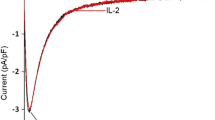Summary
A single glass micropipette voltage clamp technique with intracellular dialysis was used to study the effects of the trapidil derivatives AR 12–456 and AR 12–463 on Ca channel currents carried by Bat+ in isolated ventricular cells from mice hearts. Inspite of a more potent inhibition of the cAMP phosphodiesterase from heart (Bartel et al. 1985) a reversible Ca channel blocking action of both compounds could be observed. The concentration of half maximal block was calculated to about 50 μmol/l for both derivatives tested. Neither a shift in the current-voltage relationships nor a significant change in the potential for half maximal activation was found. The maximal Ba2+ -conductance was reduced. The steady state inactivation was shifted towards more negative potentials by application of 100 μmol/l AR 12–463. The decay of the Ba currents was accelerated in the range of the applied test potentials between −20 and +20 mV. It is concluded that the new trapidil derivatives with more potent inhibitory action on cardiac phosphodiesterase than trapidil can block myocardial Ca channels.
Similar content being viewed by others
References
Azuma J, Sawamura A, Harada H, Tanimoto T, Morita Y, Sperelakis N, Yamamura Y (1981) Trapidil stimulation of slow Ca2+ current in cardiac muscle. Eur J Pharmacol 72:199–208
Azuma J, Harada H, Sawamura A, Hasegawa H, Kishimoto S, Sperelakis N (1983) Concentration-dependent effects of trapidil on slow action potentials in cardiac muscle. J Mol Cell Cardiol 15:43–52
Bartel S, Tenor H, Krause E-G (1985) Trapidil derivatives as potent inhibitors of cyclic AMP phosphodiesterase from heart and coronary arteries. Biomed Biochim Acta 5: K31-K35
Bean BP (1984) Nitrendipine block of cardiac calcium channels: high-affinity binding to the inactivated state. Proc Natl Acad Sci USA 81:6388–6392
Belles B, Hescheler J, Trube G (1987) Changes of membrane currents in cardiac cells induced by long whole-cell recordings and tolbutamide. Pflügers Arch 409:582–588
Benndorf K, Boldt W, Nilius B (1985) Sodium current in single myocardial mouse cells. Pflügers Arch 404:190–196
Füller H, Hauschild F, Modersohn D, Thomas E (1971) Pharmakologie des 5-Methyl-7-diäthylamino-s-Triazolo (1,5-a) pyrimidine (Trapymin, Rocornal), einer Verbindung mit koronargefäßerweiternder Wirkung. Pharmazic 26:554–561
Hering S, Bodewei R, Schubert B, Krause E-G, Wollenberger A (1985) Trapidil and other 5-triazolo-(1,5-a)-pyrimidine derivatives as calcium channel blockers in 108CC5 cells. Biomed Biochim Acta 44: K37-K41
Kameyama M, Hescheler J, Hofmann F, Trautwein W (1986) Modulation of Ca current during the phosphorylation cycle in the guinea-pig heart. Pflügers Arch 407:123–128
Krause E-G, Karczewski P (1972) Hemmung der zyklo-AMP spaltenden Nukleotid-hydrolase des Herzens durch 5-Methyl-7diäthyl-s-triazolo-(1,5-a) pyrimidine (Rocornal). Acta Biol Med Germ 35:167–173
Lampe D, Mai I, Busse E (1975) Beitrag zum Wirkungsmechanismus von Trapidil (Rocornal). Pharmazie 30:807–808
Nargeot J, Nerbonne JM, Engels J, Lester HA (1983) Time course of the increase in myocardial slow inward current after a photochemical generated concentration jump of intracellular cyclic AMP. Proc Natl Acad Sci USA 80:2395–2399
Nilius B, Hess P, Lansman JB, Tsien RW (1985) A novel type of cardiac calcium channel in ventricular cells. Nature (Lond) 316:443–446
Osterrieder W, Brum G, Hescheler J, Trautwein W, Flockerzi V, Hofmann F (1982) Injection of subunits of cyclic AMP-dependent protein kinase into cardiac myocytes modulates Ca2+ current. Nature (Lond) 298:576–578
Schwartz A, Kranias EG, Abdul Malib M, Solaro RJ, Grupp I, Vaghy P (1985) Calcium movement inside cells: influence of two new positive inotropic drugs. In: Parratt JR (ed) Control and manipulation of calcium movement. Raven Press, New York, pp 107–129
Tsien RW, Bean BP, Hess P, Lansman JB, Nilius B, Nowycky MC (1986) Mechanisms of calcium channel modulation by β-adrenergic agents and dihydropyridine calcium agonists. J Mol Cell Cardiol 18:691–710
Author information
Authors and Affiliations
Additional information
Send offprint requests to B. Nilius
Rights and permissions
About this article
Cite this article
Markwardt, F., Nilius, B. Effects of trapidil-derivatives on calcium channel currents in isolated ventricular cells from mice. Naunyn-Schmiedeberg's Arch Pharmacol 337, 454–458 (1988). https://doi.org/10.1007/BF00169539
Received:
Accepted:
Issue Date:
DOI: https://doi.org/10.1007/BF00169539




